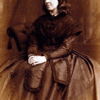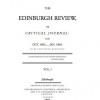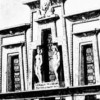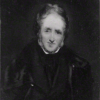
Janice Schroeder, “On the English Woman’s Journal, 1858-64″
The English Woman’s Journal (EWJ), published between 1858 and 1864, was the first monthly magazine to be published by an organized feminist network in England. From month to month, the EWJ featured a mix of articles on women’s employment, education, and volunteering, notable women in history, poetry, reviews, current events, and a readers’ column. Staffed by women with primarily female contributors, the magazine embodied the principles and opportunities for women it promoted. That is, in a rapidly changing industrial landscape, women needed new and better avenues of remunerative, meaningful employment, and the education and training required to succeed in the workforce. Marriage and motherhood—the domestic ideal—was not a guarantee of women’s economic or emotional well-being. Working with a meager budget, the circle of feminist activists—the Langham Place Group—who owned and ran the EWJ, saw their magazine as a space to promote and publicize the work they and other women were already doing. They experienced both the thrill and the shock of seeing their magazine, and themselves, noticed in the mainstream, male-dominated press. By 1862 the magazine had run into serious financial straits and many of the members of the network had either moved on to new projects or retired from public work. While maintaining a small subscription base throughout its six-year run, the appearance of the English Woman’s Journal in mid nineteenth-century England nevertheless signaled a new departure in feminist writing, women’s journalism, and attitudes towards women’s employment.

Ina Ferris, “The Debut of The Edinburgh Review, 1802″
The publication of The Edinburgh Review in October 1802 was to alter the landscape and status of periodical publications for the nineteenth century. In its entry into the lowly sphere of review writing, the new journal instituted key innovations that transformed the literary review into a powerful cultural forum within an expanding print culture.

Marjorie Stone, “Joseph Mazzini, English Writers, and the Post Office Espionage Scandal: Politics, Privacy, and Twenty-First Century Parallels”
In 1844, an English radical MP affiliated with the Chartist movement petitioned the House of Commons, charging that Sir James Graham, Secretary of State for the Home Office, had secretly authorized the opening of the letters of exiled Italian nationalist and resident of London, Joseph Mazzini, spying upon their contents. The ensuing Post Office espionage scandal is a pivotal event in British and European history, represented—like Mazzini himself—from conflicting perspectives and shaping a host of subsequent developments. It provoked “anti-Graham” envelopes and parodies in Punch, intensified British sympathy for the Italian liberation and unification movement for which Mazzini was the principal theorist, and influenced British policy towards the 1847-49 revolutions in Italian states struggling for independence from Austrian overlords and autocratic Bourbon kings. The scandal and the networks it forged also shaped British party politics, Chartist international alliances, and emerging conceptions of rights to privacy and limits on state surveillance. Mazzini, revered as an apostle by many, was viewed as a dangerous subversive by many others, including the Pope and Prince Klemens von Metternich, Foreign Secretary to the Austrian Empire, later one of Henry Kissinger’s diplomatic models. As the scandal unfolded, evidence indicated that Graham and the Foreign Secretary Lord Aberdeen shared information from Mazzini’s letters with the Austrians, linking British espionage to the execution of the Bandiera brothers, Italian revolutionaries, in Naples in July 1844. This essay surveys diverse responses to Mazzini and the literary and cultural as well as the political repercussions of the 1844 scandal. Prominent English writers, notably Thomas Carlyle, came to Mazzini’s defence, especially indignant over violations of privacy, while others—including Robert Browning, Elizabeth Barrett Browning, George Meredith, Algernon Charles Swinburne, and George Eliot—went on to write works influenced by the charismatic, controversial Italian nationalist. An epilogue notes some of the 1844 event’s parallels with current controversies over communications hacking (WikiLeaks, the News of the World phone hacking) and appropriate limits on state secrecy and surveillance in the wake of 9/11, 7/7, anti-terrorism legislation, and the “rendition” of information and/or persons such as Canadian-Syrian Maher Arar to oppressive regimes by democratic countries.

Zarena Aslami, “The Second Anglo-Afghan War, or The Return of the Uninvited”
The Second Anglo-Afghan War grew out of longstanding tensions between Russia and Britain over Britain’s prized colonial possession of India. In my account of the Second Anglo-Afghan War, I would like to emphasize two main themes. First, Afghanistan occupied an anomalous position in the British Empire. The British did not seek to colonize it or conquer it. Rather, they sought to install a sovereign who would be sympathetic to British interests, allow the British to control Afghan foreign policy, and forbid Russia from entering its borders. Second, by granting sovereignty to chosen leaders, British actions toward Afghanistan complicated the notion of sovereignty as such. The case of Afghanistan ought to remind us that it is extremely difficult to generalize how imperial power functioned across the nineteenth century and, moreover, that imperial power, in Afghanistan and other sites, was not homogeneous but rather could emanate from multiple empires at cross purposes over a single location.

Stephen Arata, “On E. W. Lane’s Edition of The Arabian Nights’ Entertainments, 1838″
The sequence of tales called in Arabic Alf Layla wa Layla was introduced to European readers by way of Antoine Galland’s enormously popular twelve-volume edition of Les mille et une nuits (1704-17). English translations of portions of Galland’s edition appear as early as 1706, and tales designated as belonging to the Arabian Nights circulated in close to one hundred separate editions published in Great Britain before 1800, all of them derived in some way from Galland. Galland had drawn from numerous sources—oral, manuscript, and print—and the provenance of many of the tales he translated was murky at best. The first efforts to produce a definitive Arabic edition of Alf Layla wa Layla date to the first quarter of the nineteenth century. Lane presented his edition as the first in English to be based on the recent Arabic editions rather than on Galland. Lane also took the unconventional view that The Arabian Nights were to be read not for their literary or entertainment value but for the historical and ethnographic light they throw on Arabic, specifically Egyptian, “life and customs and manners.” His copious and often quite lengthy annotations of the tales and his modernized system of transliteration, as well as his unapologetic pedantry, impressed and alienated his first readers in about equal measure.

Robert David Aguirre, “Mexico, Independence, and Trans-Atlantic Exchange, 1822-24”
This entry connects the Spanish American independence movements of the 1820s to the emergence of new pathways of trans-Atlantic cultural exchange. It shows that Britain’s political recognition of the new republics opened a two-way channel in which things, commodities, persons, and ideas flowed back and forth, affecting culture and politics on both sides of the Atlantic. Focusing particularly on Britain’s relations with Mexico, this entry examines key moments in the immediate British response to Spanish American independence.

Elizabeth Helsinger, “Lyric Poetry and the Event of Poems, 1870″
Dante Gabriel Rossetti’s first volume of original poetry, by most accounts, comes at the close of two decades of Pre-Raphaelite experimentation, its 1870 publication a belated event. Yet it might as easily be taken as a sign of the future, particularly the renewed lyric inventiveness of fellow poets like William Morris, Algernon Swinburne, Christina Rossetti, George Meredith, and Gerard Manley Hopkins over the next several decades. Both the poetics and the material design of Rossetti’s 1870 volume were conceived to address crises of the moment and to show the way to a future for lyric, and especially for the lyric book. What would it mean to reverse our established scholarly perspective and read the event of Poems as its author might have hoped: in light of what followed?

Linda M. Shires, “On Color Theory, 1835: George Field’s Chromatography“
George Field’s Chromatography, or, A Treatise on Colours and Pigments, and of Their Powers in Painting, &c. (January 1835) examines the properties of pigments, relations among colors, and color as a symbolic and moral force. While the color theories of Chromatography dated quickly, this seminal book’s importance to a material history of color and oil painting remains undisputed.

Morna O’Neill, “On Walter Crane and the Aims of Decorative Art”
Walter Crane (1845-1915) was one of the most important, versatile, and radical artists of the nineteenth century: a painter, decorator, designer, book illustrator, poet, author, teacher, art theorist, and socialist. As a synthesis of art, design, and politics, Crane’s career offers new insights into the tradition of painting, the status of the decorative arts, and the transgression of their boundaries at the end of the nineteenth century. His work provides an important, decorative alternative to a realist idiom for socialist art.

Jo Briggs, “1848 and 1851: A Reconsideration of the Historical Narrative”
The revolutionary year of 1848 has been seen as producing little effect on art in Britain. However, the turn to visual culture, which considers a broad spectrum of material including prints, illustrated periodicals, advertisements and other popular and ephemeral forms of visual production, allows this assumption to be rethought. By decentralizing the notion of an originary moment of formal innovation among a select group of avant-garde painters, as has been emphasized with regard to Paris, and turning to British visual culture, the effects of revolution become diffuse and plural. As a result, chronologies need to be rethought, and the revolutions of 1848 and the Great Exhibition of the Work of Industry of All Nations of 1851 reconnected.
